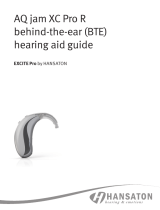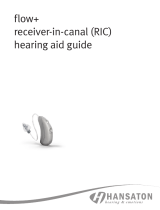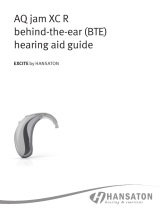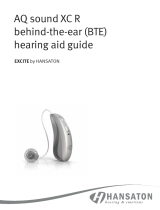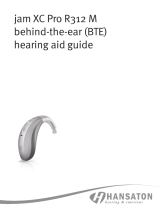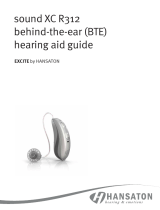Page is loading ...

AQ beat ST R
hearing aid
user guide

This user guide applies to the following models:
Hearing aids
AQ beat ST -R
AQ beat ST -R
AQ beat ST -R
AQ beat ST -R
AQ beat ST -R*
AQ beat ST myChoice
Non wireless charging
accessory
HANSATON Charger
Your hearing aids
Hearing care professional: ____________________
___________________________________________
Telephone: _________________________________
Model: ____________________________________
Serial number: ______________________________
Warranty: __________________________________
Program 1 is for: ____________________________
Program 2 is for: ____________________________
Program 3 is for: ____________________________
Program 4 is for: ____________________________
Date of purchase:____________________________
*Not available in all markets.

Quick reference Thank you for choosing these hearing aids.
Please read the User guide carefully to make
sure that you understand and get the best out
of your hearing aids. Training is not required
for handling of this device. A hearing care
professional will help setup the hearing aids to
your individual preferences.
For more information regarding features,
benets, setup, use and maintenance or repairs
of your hearing aid and accessories – contact
your hearing care professional or manufacturer
representative. Additional information can be
found in the specication sheet of your product.
beeps every
minutes
Low battery warning
Turning hearing aids on/o
Press and hold the lower part of the button on each hearing
aid for 3 seconds until the indicator lights change.
On: Indicator light is
temporarily solid green
O: Indicator light is
temporarily solid red
Before using your hearing aids for the rst time,
it is recommended to charge them for 3 hours.
Multi-function button
with indicator light
Charging your hearing aids
Insert the hearing aids rmly into the
charger. Watch that the lights are
blinking to conrm the hearing aids
are charging.
Charging: Slow blinking
indicator light
Fully charged: Solid green indicator light
On O

1. Your hearing aids at a glance ................................................ 2
2. Turning your hearingaids onando ................................... 5
3. Putting your hearing aids on your ears ................................. 6
4. Operating instructions .........................................................8
Your rechargeable hearing aids ........................................12
Charging your hearing aids ...............................................14
Pairing your mobile phone with your hearing aids............19
Using your mobile phone with your hearing aids ............. 22
TV Connector .................................................................... 27
Tinnitus masker ................................................................28
Flight mode ...................................................................... 29
5. Caring for your hearing aids ................................................30
6. Accessories ........................................................................ 34
7. Troubleshooting guide ....................................................... 36
8. Important safety information ............................................ 43
9. Operating, transport and storage conditions .....................66
10. Information and explanation of symbols ......................... 67
11. Compliance information ......................................................71
12.
Warning to hearing aid dispensers (tocomplywith the
U.S. Food and
Drug Administration (FDA) regulations) ..........75
Table of contents

2 3
AQ beat ST R BTE hearing aids
2
1
2
2
1
2
3
4
5
6
7
8
1. Your hearing aids at a glance
1 Multi-function button with indicator light -
switches between listening programs, changes
the volume level, and accepts or rejects mobile
phone calls depending on your customized tting
2 Microphone - sound enters your hearing aids
through the microphones. Microphone shield -
protects microphones from dirt & debris
3 Earhook - your custom made earmold attaches to
your hearing aids using the earhook
4 Tubing - part of the earmold that attaches it to the
earhook
5 Earmold - allows the sound to pass from the
hearing aids to the ear and holds the hearing aids
in place
6 Slim tube - sound travels down the slim tube to
the ear canal
7 Dome - holds the slim tube in place in your ear
canal
8 Retention piece - helps prevent the dome and
slim tube from moving out of the ear canal

4 5
2. Turning your hearingaids onando
Your hearing aids will turn on
automatically when removed from
the charger. To turn hearing aids on
and o when not using the charger,
press and hold the lower part of the
button on each hearing aid for 3 seconds until
the indicator lights change.
On: Indicator light is
temporarily solid
green
O: Indicator light is
temporarily solid red
Before using your hearing aids for the rst
time, it is recommended to charge them for
3 hours.
When you turn your hearing aids on you
may hear a start-up melody.
On O
Space for earpieces
Hearing aid charging slots with le/right indicators
Charger
Charger
Indicator light for power
USB-C connection
to external power supply

6 7
Hearing aids with earmolds
1. Hold the earmold between
your thumb and index
nger, with the opening
facing toward your ear
canal and the hearing aid
resting above your ear.
2. Carefully insert the
earmold in your ear. You
may need to twist it slightly
to the back. The earmold
should t into your ear
snugly and comfortably.
Gently pull down and back
on your earlobe to help you
insert the earmold into your
ear canal more easily.
3. Place the hearing aid over
the top of your ear.
Labeling
The serial number and year of manufacture
are located under the colored hearing aid
marking.
1.
2.
3.
3. Putting your hearing aids on your
ears
Your hearing aids will be color-coded with a
marking on the outside of the hearing aid:
red = right ear; blue = le ear.
Hearing aids with domes
1. Place the hearing aid over
the top of your ear.
2. Hold the tube where it
attaches to the dome and
gently push the dome into
your ear canal. The tube
should lie flush against
your head and not stick out.
3. If there is a retention piece,
place it in your ear so it
rests at the bottom of the
opening of your ear canal.
2.
3.
1.

8 9
Program control
Each time you push the upper part of the button
on either hearing aid for longer than 2 seconds,
you will move to the next hearing aid program.
Your hearing aids beep to indicate which
program you are in.
Program setting Beeps
Program 1 (e.g. automatic program) 1 beep
Program 2 (e.g. speech in noise) 2 beeps
Program 3 (e.g. Telephone) 3 beeps
Program 4 (e.g. music) 4 beeps
Please see the front of this booklet for a listing
of your personalized programs.
4. Operating instructions
Your hearing aids come with a multi-function
button that allows you to further adjust them.
You may also use the multi-function button
to accept and reject calls to your paired
mobile phone. You may also use the optional
RemoteControl or stream remote App to control
your hearing aids.
These instructions describe the default
multi-function button settings. Your
hearing care professional may change
the functionality of the buttons. See
your hearing care professional for more
information.
Multi-function button
The multi-function button on your
hearing aids can be both a volume
control and a program control.

10 11
Tap control
If paired with a Bluetooth® enabled device,
multiple functions can be accessed using tap
control e.g. accept/end phone call, pause/
resume streaming, start/stop voice assistant.
To use tap control tap the top of your ear twice.
Volume control
To adjust the volume of your environment:
• Push the upper part of the hearing aid
button to increase the volume, and
• Push the lower part of the hearing aid
button to decrease the volume
As you change the volume, your hearing aids
will beep.
Volume setting Beeps
Suggested volume level 1 beep
Turning volume up short beep
Turning volume down short beep
Maximum volume level 2 beeps
Minimum volume level 2 beeps
Bluetooth® is a registered trademark owned by the Bluetooth SIG, Inc.

12 13
Charging information
The hearing aids must be dry before charging.
Charge your hearing aids every night. If you hear
the low battery warning, place your hearing
aids in the charger.
Please ensure to charge and use the hearing
aids within operating temperature range:
+5° to +40° Celsius (41° to 104° Fahrenheit).
If the charger is removed from the power source
during charging, the hearing aids will turn on
and will start to discharge. Ensure the charger
remains powered while the hearing aids are in
the charger.
Your rechargeable hearing aids
Battery information
Before using your hearing aids for the rst time,
it is recommended to charge them for 3 hours.
These hearing aids contain a built-in and
non-removable rechargeable lithium-ion
battery.
Two long beeps indicate the hearing aid battery
is low. You have approximately 60 minutes
before you have to charge the hearing aids (this
can vary depending on the hearing aid settings).
If you can’t hear the low battery warning, your
hearing care professional can change its pitch
or loudness. If you prefer, it can be turned o
entirely.

14 15
Power supply specication
Power supply output voltage 5 VDC +/-10%,
current 1 A
Power supply input voltage 100-240 VAC, 50/60Hz,
current 0.25 A
Charger input voltage 5 VDC +/-10%,
current 500mA
USB cable specications 5 V min. 1 A, USB-A to
USB-C, maximum
length 3 m
2) Insert the hearing aids
Insert the hearing aids rmly into the charging
slots. Make sure the le and right hearing
aid markings match the le (blue)/right (red)
indicators in front of the charging slots. The
hearing aids will automatically switch o when
inserted into the charger.
Charging your hearing aids
1) Connecting the power supply
a) Plug the larger end of the charging cable into
the power supply.
b) Plug the smaller end into the USB-C port on
the charger.
c) Plug the power supply into a power outlet.
d) The indicator light is green when the charger
is connected to the power supply.
ab
d
c

16 17
Indicator light Percentage charged Charging time
-%
-8%
30 min (30%)
60 min (50%)
90 min (80%)
8-%
% h
Understanding the indicator light
The below table indicates battery charging time
from fully depleted.
3) Watch the indicator light
The indicator light will slowly blink until the
hearing aids are fully charged. When fully
charged the indicator light will be solid green.
The charging process will automatically stop
when the batteries are fully charged, so the
hearing aids can be safely le in the charger.
It can take up to 3 hours to charge the hearing
aids. The charger cover can be closed while
charging.

18 19
Pairing your mobile phone with your
hearing aids
1. On your phone, go to your settings menu to
ensure Bluetooth® is on and to search for
Bluetooth enabled devices.
2. Turn your hearing aids on. Your hearing aids
will remain in pairing mode for 3 minutes.
3. Your phone will show a list of found
Bluetooth enabled devices. Select your
hearing aid from the list to simultaneously
pair both hearing aids. You will hear
a melody when your phone has been
successfully paired to your hearing aids.
It is only necessary to perform the pairing
procedure once with each Bluetooth enabled
phone.
Consult your phone user guide for instructions
on pairing a Bluetooth device with your phone.
Bluetooth® is a registered trademark owned by the Bluetooth SIG, Inc.
4) Remove the hearing aids from the charger
Remove the hearing aids from the charging
slots by pulling up and towards the front of the
charger to turn them on.
Do not pull the tubes to remove the hearing aids
from the charger as this can damage the tubes.

20 21
Phone calls with a mobile phone
Your hearing aids allow direct communication
with Bluetooth enabled devices. When paired
and connected to a phone, you will hear the
caller’s voice directly in your hearing aids.
Your hearing aids pick up your voice through
their own microphones. Two active Bluetooth
devices such as a phone can be connected to
your hearing aids, with support for additional
pairings.
You do not need to hold your mobile phone close
to your mouth, your voice is transmitted through
the hearing aids to your mobile phone.
Caller’s voice
Your voice
Connecting to your mobile phone
Aer your hearing aids have been paired to your
phone, they will automatically connect again
when your phone and hearing aids are turned
on and in range. This can take up to 2 minutes.
The connection will be maintained as long as
the phone remains on and within a range of
up to 10 m (30 ).
To switch a call between your hearing aids and
the speaker on your mobile phone, select the
audio source you would like from your phone.
If you are not sure how to do this, consult the
instruction manual that came with your mobile
phone.

22 23
Accepting a mobile phone call
When receiving a call, an incoming call
notication will be heard in the hearing aids.
The call can be accepted by tapping the top of
your ear twice, or with a short push of less than
2 seconds on either the upper or lower part of
the button on either hearing aid. Alternatively,
accept the call on your phone as you normally
would.
Le Right
short push
< 2 sec
tap ear
twice
or
Using your mobile phone with your
hearing aids
Making a phone call
Start a call on your paired mobile phone as you
normally would. You will hear the audio through
your hearing aids. Your hearing aids pick up your
voice through their own microphones.

24 25
Rejecting a phone call
An incoming call can be rejected by holding
down the upper or lower part of the button
on either hearing aid for more than 2 seconds.
Alternatively, reject the call on your phone as
you normally would.
Ending a phone call
End a call by tapping the top of your ear twice,
or by holding down the upper or lower part of
the button on either hearing aid for more than
2 seconds. Alternatively, end the call on your
phone as you normally would.
Le Right
long push
> 2 sec
tap ear
twice
or

26 27
TV Connector
Adjusting volume balance between the TV
and the sounds in your environment
While listening to TV sound through the
TV Connector accessory:
• Push the upper part of the hearing aid
button to increase the TV volume and
decrease the volume of sounds in your
environment
• Push the lower part of the hearing aid
button to decrease the TV volume and
increase the volume of sounds in your
environment
Le Right
TV volume down
TV volume up
Adjusting volume balance between mobile
phone calls and your environment
During a call using a paired mobile phone:
• Push the upper part of the hearing aid
button to increase the call volume and
decrease the volume of sounds in your
environment
• Push the lower part of the hearing aid
button to decrease the call volume and
increase the volume of sounds in your
environment
Le Right
Call volume up
Call volume down

28 29
Flight mode
Your hearing aids operate in the frequency
range of . GHz–.8 GHz. When flying, some
airlines require all devices to be switched into
flight mode. Entering flight mode will not disable
normal hearing aid functionality, only the
Bluetooth connectivity functions.
Entering flight mode
To disable the Bluetooth wireless function and
enter flight mode:
With the hearing aid turned o,
push and hold the lower part of
the button for seconds until
the solid orange light appears.
Then release the button.
Exiting flight mode
To enable the Bluetooth wireless
function and to exit flight mode:
Switch the hearing aid o and
then on using the lower part of
the hearing aid button.
Tinnitus masker
If your hearing care professional has congured
a tinnitus masker program, you can adjust
the tinnitus masker level while you are in the
tinnitus masker program. To adjust the noise
level:
• Push the upper part of the hearing aid
button to increase the tinnitus masker, and
• Push the lower part of the hearing aid
button to decrease the tinnitus masker
stream remote App:
• Tap the advanced features button where
you can adjust the tinnitus masker volume
up or down
As you change the level, your hearing aids will
beep.

30 31
• Do not drop your hearing aids or knock them
against hard surfaces.
Cleaning your hearing aids
Use a so cloth to clean your hearing aids at
the end of each day. Regular cleaning of the
microphone ports with the supplied cleaning
brush will ensure that your hearing aids will
maintain their sound quality. Your hearing care
professional can demonstrate this for you.
Place the hearing aids in the charger overnight.
Ear wax is natural and common. Ensuring your
hearing aids are free of ear wax is an important
step in your daily cleaning and maintenance
routine.
Never use alcohol to clean your hearing aids,
earmolds or domes.
Do not use sharp tools to dislodge ear wax.
Sticking household items into your hearing aids
or custom molds can seriously damage them.
5. Caring for your hearing aids
Protecting your hearing aids
• Diligent and routine care of your hearing
aids and charger contribute to outstanding
performance and a long service life. To ensure
a long service life, Sonova AG provides a
minimum of a ve year service period aer
phase out of the respective hearing aid.
• Always remove your hearing aids when
using hair care products. The hearing aids
can become clogged and cease to function
properly.
• Do not wear your hearing aids in the bath or
shower or immerse them in water.
• If your hearing aids do become wet, do not
attempt to dry them in an oven or microwave.
Do not adjust any controls.
• Protect your hearing aids from excessive heat
(hair dryer, vehicle glove box or dashboard).
• Ensure you do not twist or squeeze the tubes
when your hearing aids are placed in their case.

32 33
5. Using the black cleaning pin
provided in the kit, gently
insert the cleaning pin where
the slim tube attaches to the
hearing aid and push the pin
all the way through the tube.
Note: The slim tubes and domes should never
be rinsed or submerged in water as water drops
may become lodged in the tube, block sound
or damage the electrical components of the
hearing aid.
6. Once the slim tube has been cleaned,
reattach it by gently turning the hearing aid
onto the slim tube.
7. Reattach the dome to the slim tube by gently
pushing it back onto the threading at the
end of the tube. You will feel the dome click
onto the ridges of the slim tube, and you
won’t be able to push it any further.
Cleaning your slim tubes and domes
You should have the slim tubes
and domes replaced by your
hearing healthcare professional
approximately every three to six
months or when they become sti, brittle, or
discolored.
Clean the outside of the domes at the end of
each day with a damp cloth. Avoid getting any
water in and around the hearing aids.
You should also clean the slim tubes
periodically, with the cleaning pin provided,
when you begin to notice debris in and around
the tubes.
1. Hold the slim tube in one hand and the
hearing aid in the other hand.
2. Gently turn the hearing aid until it detaches
from the slim tube.
3. Use a damp cloth to clean the outside of the
slim tube and dome.
4. Remove the dome from the slim tube by
pulling gently, before cleaning the slim tube.
/
